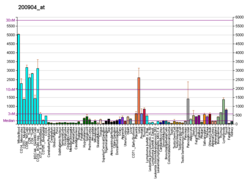| HLA-E |
|---|
 |
| Estruturas disponíveis |
|---|
| PDB | Pesquisa Human UniProt: PDBe RCSB |
|---|
| Lista de códigos id do PDB |
|---|
3CII, 1KPR, 1KTL, 1MHE, 2ESV, 3AM8, 3BZE, 3BZF, 3CDG |
|
|
| Identificadores |
|---|
| Nomes alternativos | HLA-E, antígeno de histocompatibilidade HLA classe I, cadeia alfa E, antígeno MHC classe I E |
|---|
| IDs externos | OMIM: 143010 HomoloGene: 134018 GeneCards: HLA-E |
|---|
| Ontologia genética |
|---|
| Função molecular | • beta-2-microglobulin binding
• MHC class I protein binding
• signaling receptor binding
• natural killer cell lectin-like receptor binding
• peptide antigen binding
• T cell receptor binding
|
|---|
| Componente celular | • integral component of membrane
• phagocytic vesicle membrane
• early endosome membrane
• membrane
• MHC class Ib protein complex
• Golgi membrane
• membrana plasmática
• cell surface
• MHC class I protein complex
• ER to Golgi transport vesicle membrane
• integral component of lumenal side of endoplasmic reticulum membrane
• Exossoma
• recycling endosome membrane
|
|---|
| Processo biológico | • antigen processing and presentation
• adaptive immune response
• antigen processing and presentation of exogenous peptide antigen via MHC class I, TAP-dependent
• CD8-positive, alpha-beta T cell activation
• interferon-gamma-mediated signaling pathway
• processo do sistema imunitário
• antigen processing and presentation of peptide antigen via MHC class I
• positive regulation of T cell mediated cytotoxicity
• positive regulation of TRAIL production
• positive regulation of interleukin-4 production
• antigen processing and presentation of exogenous peptide antigen via MHC class I, TAP-independent
• protection from natural killer cell mediated cytotoxicity
• positive regulation of interleukin-13 production
• type I interferon signaling pathway
• GO:0046730, GO:0046737, GO:0046738, GO:0046736 resposta imunitária
• regulation of natural killer cell mediated immunity
• positive regulation of natural killer cell mediated immunity
• regulation of immune response
• positive regulation of tumor necrosis factor production
• sistema imune inato
• positive regulation of CD8-positive, alpha-beta T cell proliferation
• antigen processing and presentation of endogenous peptide antigen via MHC class Ib
|
|---|
| Sources:Amigo / QuickGO |
|
|
| Ortólogos |
|---|
| Espécie | Humano | Rato |
|---|
| Entrez | | |
|---|
| Ensembl | ENSG00000204592
ENSG00000225201
ENSG00000236632
ENSG00000230254
ENSG00000206493
|
|---|
ENSG00000233904
ENSG00000229252 |
| |
|---|
| UniProt | | |
|---|
| RefSeq (mRNA) | | |
|---|
| RefSeq (proteína) | | |
|---|
| Localização (UCSC) | n/a | n/a |
|---|
| Pesquisa PubMed | [1] | n/a |
|---|
|
| Wikidata |
|

 . PMID 29422902. doi:10.3389/fimmu.2018.00060. Consultado em 12 de agosto de 2021
. PMID 29422902. doi:10.3389/fimmu.2018.00060. Consultado em 12 de agosto de 2021 

 Portal da genética
Portal da genética
















